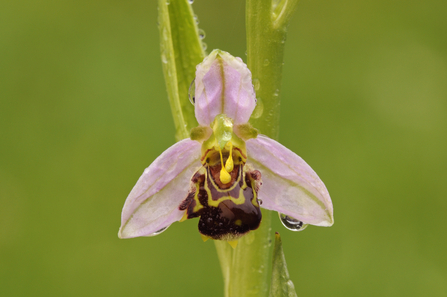
Bee orchid by Dawn Monrose
The bee orchid is one of the most beautiful and well known of the native orchids in Britain. Although it is not a common species and is less frequent than it used to be, it can still often be found in Suffolk.
How to recognise a bee orchid
Flowers consist of:
• Two greenish pink upper petals
• Three rosy-pink sepals
• Rich brown, furry expanded lower, giving it the appearance of a bumblebee on its flowers
Other features:
• Green, hairless stem, between 10-15cm tall
• Up to 10 flowers produced in a long loose spike
• Grey-green, pointed, elliptical leaves forming a rosette at the base of the stem that withers as the flowers appear
Where are bee orchids found?
The bee orchid has a preference for chalky soils and in Suffolk particularly occurs on boulder clay. However, unlike some orchid species it is also known to tolerate neutral soils and even occasionally sands and gravel. It can be found in grassland, such as rough pasture, damp meadows, woodland rides, road verges and railway embankments.
It is an opportunistic species that can be quick to colonise disturbed habitats such as spoil heaps, derelict farmland. In these situations bee orchids can appear in very high numbers for a few years and then disappear as it is outcompeted by more vigorous grassland species.
Lifestyle
Originally called the 'humble bee orchid', this species was given its name because the flowers mimic a female bee, both in scent and appearance. In this way the male bee is tricked into landing on the flower and attempting to mate with it. When the bee moves on to another plant, the pollen it has picked up from the first orchid is transferred to the next. In addition, bee orchids are able to self pollinate in the absence of a suitable insect pollinator.
Bee orchids may only flower once in their lifetime, which explains their appearance in large numbers in some years and disappearance in others. The seeds germinate in the spring and can take as long as six years before they reach a flowering stage.
Legal protection
Bee orchids are protected, as are all wild flowers, under Section 13 of the Wildlife and Countryside Act (1981). This section prohibits unauthorised and intentional uprooting of any wild plant. In addition, because orchids are particularly slow growing and may only flower once in their lifetime, it is important to never pick the flowers.
Although the species is perhaps not as rare as people may think, the destruction of grassland habitat through development and agricultural intensification can quickly restrict and isolate colonies of species such as bee orchid.
Management
Grasslands need to be cut or grazed in order to divert natural succession and prevent vigorous grasses and eventually scrub from developing.
In most cases, a cut late in July will allow the bee orchid and other wild flowers the opportunity to flower and set seed. After cutting, it is very important to rake off and remove the clippings. If left on, they may smother delicate plants and increase fertility, which encourages rank growth at the expense of wild flowers. If clippings are left to dry for a few days after cutting, flowers can then shed any ripe seed.
Chemicals should not be used. Herbicides can cause damage by eradicating wild flowers and grasses as well as ‘weeds’. Fertilisers also are harmful in that they encourage the growth of more vigorous species.
